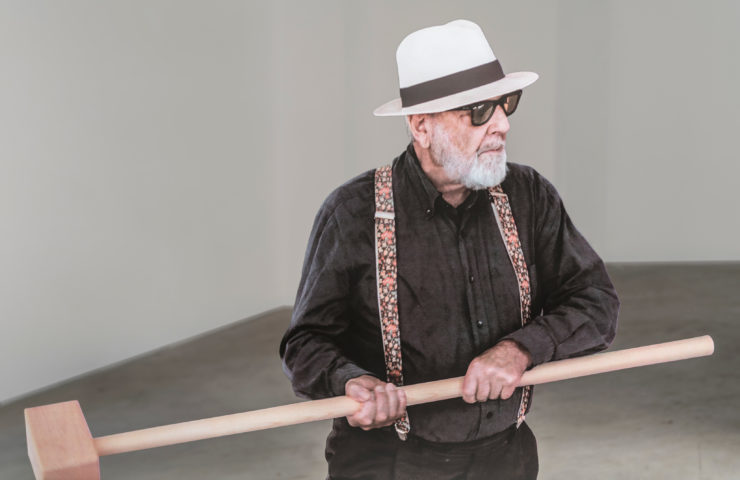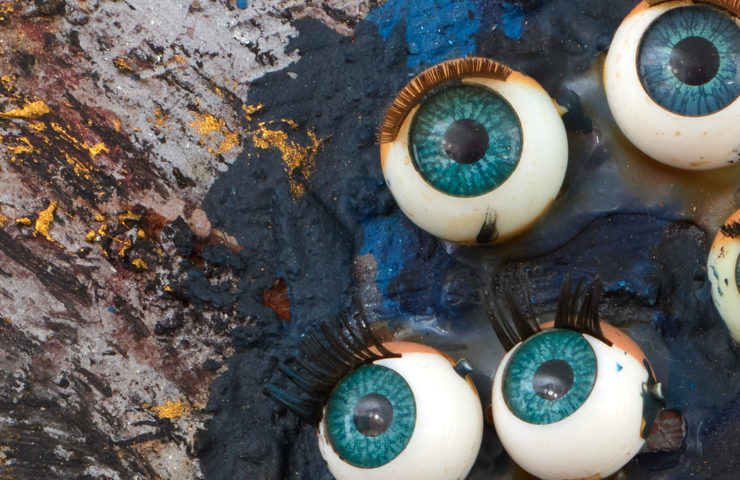Lygia Clark
Bicho em Si – Pq, 1966
Aluminum
11 3/4 x 12 x 11 3/4 inches (29.8 x 30.5 x 29.8 cm)
© O Mundo de Lygia Clark-Associação Cultural, Rio de Janeiro
Photo: Farzad Owrang
The conjunction of your gestures with the immediate response of the Bicho creates a new relationship, and this is only possible because of the movements the Bicho knows how to perform by itself: it is the Bicho’s own life.
—Lygia Clark
Lygia Clark—whose work will be featured in the important solo exhibition Painting as an Expanded Field at the Guggenheim Bilbao this year—was a central figure in Brazil’s avant-garde. Clark’s Bichos take their name from the Portuguese word for “beast” or “critter.” Created with the help of fabricators in a variety of metals, including stainless steel and patinated aluminum, about 70 were made between 1960 and 1966. Each consists of geometric planes connected by hinges that allow them to be arranged in multiple configurations. The Bichos thus have no given form; rather, their form emerges through a series of folding and unfolding gestures that are uniquely performed by each viewer who encounters them. In Clark’s understanding, this encounter consisted of two parts: the first was an external action, initiated by the spectator, while the second was a movement internal to the Bicho, “produced by the dynamics of its own expressiveness,” in her words.
Trained as a painter in Rio de Janeiro and Paris, Clark was an original member of Neo-Concretism. In their 1959 manifesto, insisting that their compositions were guided by intuition rather than calculation, the Neo-Concretists privileged subjective expression and poetic experimentation. Produced after this heady period of debates around painting, the Bichos mark a turning point in Clark’s early career, signaling her movement into three dimensions and her embrace of a mode of artmaking that incorporated time, change, and lived experience. While not explicitly figurative, each Bicho consisted of interconnected parts, like an organism; its hinges recall backbones or vertebrae, while its overall appearance recalls that of a crustacean, mollusk, or shell.
Bicho em Si – Pq (1966) consists of a series of sinuous curves that elaborate Clark’s fascination with the Möbius strip. As a surface without start or finish, the Möbius strip neither separates nor binds, and “makes us live the experience of a time without limit and a continuous space,” according to Clark. The form of Bicho em Si – Pq is fundamentally unfixed—and, in this way, it has no single author, as it is constantly remade anew. “The work is the act of making the work, the work and you are totally transformed into an indissociable one,” Clark explained. “Bicho em Si – Pq” thus enacts her utopian ideal of a fusion that dissolves boundaries among self, other, and world, yielding a state of oneness.
Bicho em Si – Pq was presented by Clark to the Spanish sculptor Miguel Ortiz Berrocal at the 1973 Bienal de São Paulo. Best known for his puzzle sculptures, Berrocal was, like Clark, inspired by the seemingly infinite variations that resulted from the interactions of form, geometry, and space. The artists’ shared intellectual pursuits formed the basis of a close friendship from which the exchange of ideas and work ensued. Berrocal’s interest in the iterative nature of Bicho em Si – Pq is evidenced in archival photographs that show the artist engaging with and diagrammatically illustrating the Bicho’s multitudinous configurations. Berrocal’s respect for Clark and continued fascination with the present work were such that he kept the sculpture on his personal desk, and it remained in the artist’s collection until his death in 2006.
This work is accompanied by a certificate of authenticity issued by o mundo de Lygia Clark, numbered 000920.
-

Andy Warhol
Ladies and Gentlemen (Wilhelmina Ross), 1975
-

Eduardo Chillida
Gure aitaren etxea, 1984
-

Carol Rama
Presagi di Birnam (Omens of Birnam), 1994
-

Mario Schifano
Untitled, 1975
-

Michelangelo Pistoletto
Rottura dello specchio–azione 2, 2017
-

Lygia Clark
Bicho em Si – Pq, 1966
-

Frank Stella
Untitled, 1969
-

Enrico Castellani
Superficie argento, 2006
-

Jana Euler
Dirty Gossip Rain, 2013
-

Carol Rama
Bricolage, 1963
-

Mickelane Thomas
Sugar Baby, 2004







